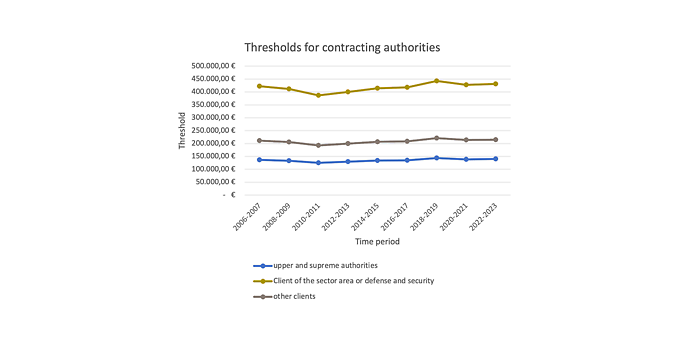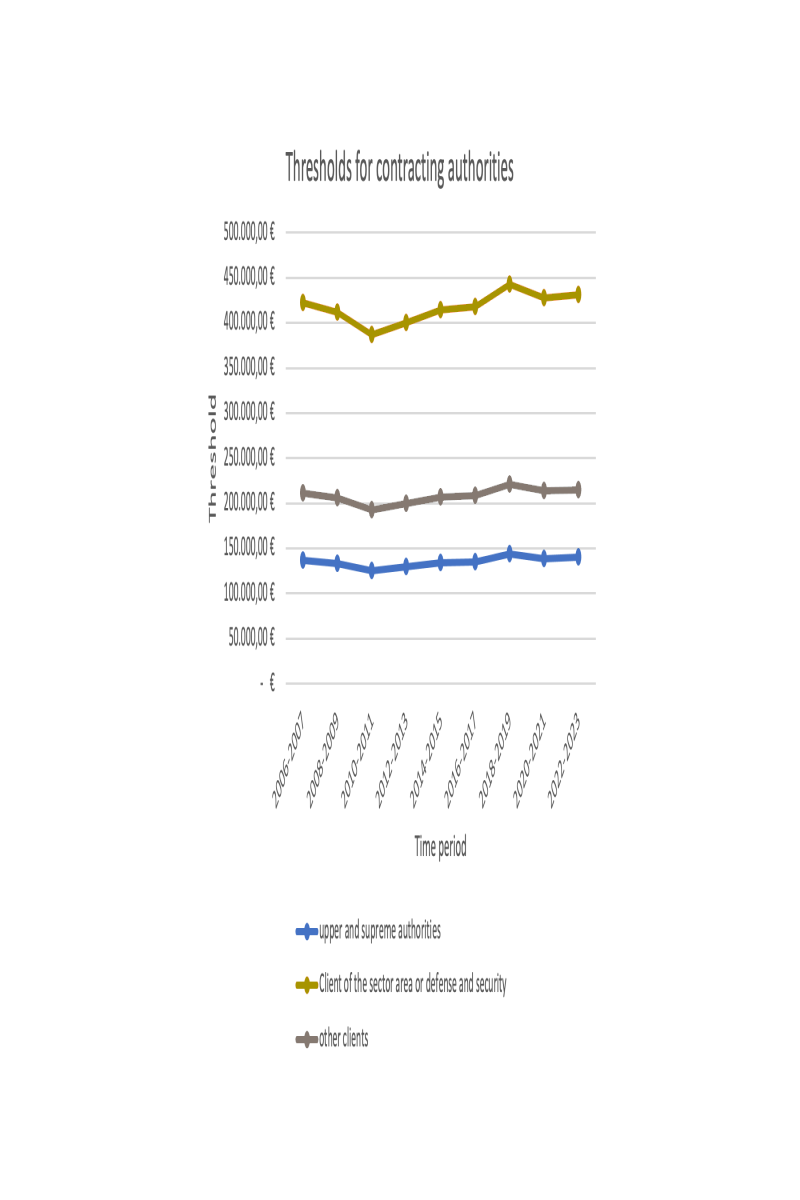2. March 2022 By Marcel Penstorf
New thresholds for 2022 and 2023 separate EU-wide tenders from national tenders
About net order volumes and thresholds
In order to give you a better understanding of the term ‘threshold’, I first need to describe the term ‘net order volume’ in more detail. The net order volume is the estimated order or contract value excluding VAT. All options and the maximum period are included when estimating the volume – when doing this for framework agreements, for example, the sum of all lots and the optional period extensions are included. This prevents contractors from ‘cheating’ by dividing smaller contract volumes into smaller lots in order to save time and costs in the tendering process.
The threshold value determines the threshold for the net contract volume, above which the procurement regulations take effect. This means if the net contract volume reaches or exceeds the threshold, the public contract is subject to procurement regulations. Such contracts must be tendered throughout the entire EU. This means that tendering is subject to stricter laws and longer deadlines. It is therefore more costly – financially and in terms of time. If, on the other hand, the net contract volume is estimated to be lower, national tenders can be issued. Different rules apply in the individual federal states.
Where do the thresholds come from and who sets them? Let me explain.
I promise that the sentence you’re about to read will be the most complicated one in this blog post: The EU Commission reviews the thresholds for procurement procedures in the EU every two years to ensure that they comply with the World Trade Organization’s (WHO) only legally binding ‘Government Procurement Agreement’ (GPA) and publishes them in the Official Journal of the EU. The EU Commission doesn’t have free reign when doing so, as there is a fixed mathematical calculation that must be followed. In the GPA, the WHO defined an artificial currency (SDR [Special Drawing Right]) as a mixture of US dollar, euro, pound sterling and yen. Since currencies are subject to exchange rate fluctuations, the EU Commission must adjust the thresholds every two years. EU member states are free to set lower and thus stricter values. Germany, however, doesn’t do this.
New thresholds for 2022 and 2023
A distinction is made between three different thresholds for contracting authorities and at what point they must open calls for tender throughout the EU.
The lowest threshold applies to higher and supreme federal authorities, such as our client the German Federal Office of Administration (Bundesverwaltungsamt). These authorities must open calls for tender throughout the EU beginning at the €140,000 threshold. The highest threshold (€431,000) applies to the utilities sector and defence and security authorities. The utilities sector includes our client Deutsche Bahn, for example, or clients from numerous municipal utilities and the four power grid operators. The €215,000 threshold applies to all other authorities.

Every two years, the thresholds were adjusted due to the fluctuations in the euro exchange rate.
Legal provisions for awarding contracts and EU-wide procedures
For us in proposal management, the rules of the game change depending on the procedure. The EU-wide procedures take effect when the thresholds are exceeded. The German Procurement Ordinance (Vergabeverordnung, VgV), the German Defence and Security Procurement Regulation (Vergabeverordnung Verteidigung und Sicherheit, VSVgV) or the German Utilities Regulation (Sektorenverordnung, SektVO) apply here. The announcements of these tenders can be found in the Tenders Electronic Daily (TED) at https://ted.europa.eu.
Where the thresholds are not exceeded, contracts are awarded nationally. Various national regulations come into play here. The German Regulation on Sub-Threshold Procurement (Unterschwellenvergabeordnung, UVgO) is new and has been adopted by many German states. A few German states are still following the German Regulations on Contract Awards for Public Supplies and Services (Vergabe- und Vertragsordnung für Leistungen, VOL/A). The Service.Bund.de portal provides centralised access to the federal, state and local administrations’ electronic tenders and to the federal administration’s authorities and institutions.
Tenders are time-consuming and therefore costly for bidders and contractors. In order to keep the cost smaller than the contract value, the cost-minimising rule is used when awarding contracts directly. When awarding contracts directly, the contracting authority may obtain tenders from at least three bidders it knows without giving other bidders the opportunity to compete. Our dedicated sales team sees to it that adesso is invited to submit a bid. In the end, the contracting authority awards the contract to the bidder with the most economical offer. This is because the price-performance ratio is taken into account when making an offer, meaning that quality is also a deciding factor. As a result, the most economical bid doesn’t necessarily have to be the lowest bid in terms of price.
Conclusion
We can already roughly estimate the net contract volume based on the type of tender and the threshold value associated with it. The national awards begin with the direct awards in the low five-figure range in particular. For EU-wide procedures, on the other hand, we automatically move into projects with at least a six-figure turnover. Due to the stricter laws, we in proposal management have numerous requirements and forms to process when the threshold value is exceeded (where EU-wide procedures come into play). This makes it so that a large amount of administrative effort is required to prepare the offer. If, on the other hand, the client opens a call for tender below the threshold value (that is, with a low estimated net order volume) the administrative effort for us is low, but not our commitment to fulfilling the client’s wishes despite a small budget – because adesso offers every client the right offer and the best performance.
You will find more exciting topics from the adesso world in our latest blog posts.


